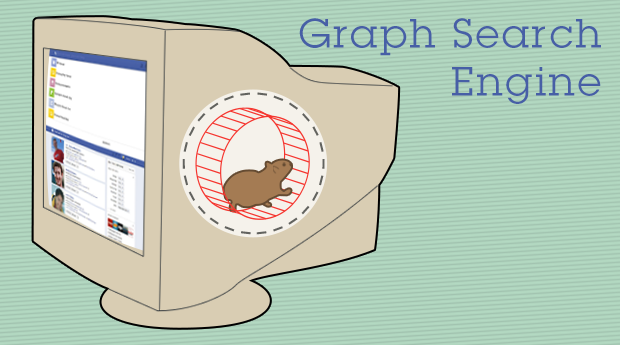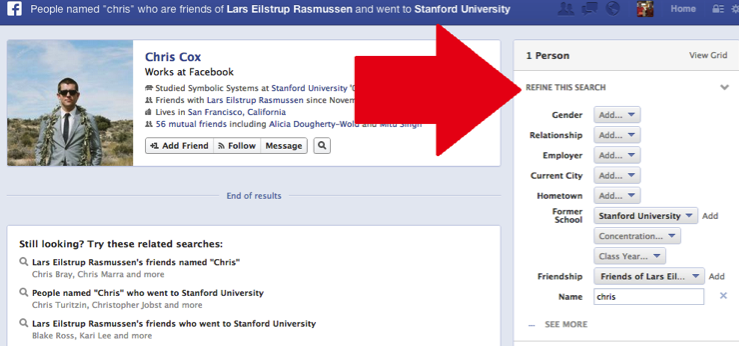Facebook Graph Search Deconstructed

1 billion people. 240 billion photos. 1 trillion connections.
Facebook helps us stay connected to the people, places and things we love. However, the social network is pushing us to open up our world and do more. It wants us to not only connect to our friends, but to use our personal stories and experiences to help us answer life’s most pressing questions, like:
Where can I find a vegan restaurant in Mobile, Alabama?
Facebook’s new Graph Search will help us do just that by using our friends’ likes and interests to personalize search results. Unless you’ve been hiding under a rock, you’ve probably heard of Graph Search but, unless you’re one of the lucky few who made it into the product’s beta testing, you probably haven’t used it.
We’ve created a breakdown to outline how Graph Search works based on information we received from Facebook Project Manager, Loren Cheng, along with some recent developments we’ve learned about since the product launched early this year.
What It’s About
Facebook considers itself to have three pillars:
- Newsfeed – The page we visit to see what our friends and the brands we follow are saying and sharing.
- Timeline – Our homebase on Facebook, where we curate our own experiences, pictures, check-ins and photos to share with others
- Graph Search – ???
So, how does Graph Search fit into all this? Basically, it is a new way to search using all the information you and your friends have shared including photos, images, check-ins, likes and more. While other services index primarily public information, Facebook is able to answer the questions that others can’t by indexing things people share to help other users make decisions.
How is this different (or better) than searching on Google or Bing? It all boils down to reach and relevance. We benefit from the vast reach of Google and Bing, but have to sift through information to uncover relevance. However, Graph Search breaks this tradeoff by combining the two. We get to learn about restaurants, books and other things of interest in our area, while also getting the inside scoop from the experiences of those closest to us – helping us to determine whether something is a “yay” or a “nay.”
How It Works
Let’s say after finding that vegan restaurant, I need to see a dentist because I chipped a tooth on some overcooked tempeh. I could conduct a Google or Bing search to find a list of dentists in the area, then do my due diligence to identify the best options. Or, I could use Graph Search to find dentists my friends in Alabama like. Graph Search currently allows you to search by the following criteria:
- People – Our friends, friends of friends and people we follow
- Photos – Check-ins, captions and comments
- Places – Places we’ve checked into
- Pages – Pages we’ve liked
- Interests – Interests we’ve liked
Using natural language, we can type our query into graph search asking:
- Dentists liked by my friends
- Which dentists in Alabama are liked by my friends and have pictures
- Dentists in Alabama liked by my friends who like Mad Men

Now, let’s say we don’t trust some of our friend’s judgment. Graph search lets us further define our results to exclude certain information.

Natural Language
In stark contrast to Google, Facebook Graph Search encourages the use of super long-tail search queries, emphasizing phrases and not keywords. This is because Facebook Graph Search responds to natural language. The developers felt that understanding semantics was key to making Graph Search work. By utilizing natural language patterns, Graph Search provides users the ability to ask almost anything. This also required a certain amount of re-education. We are trained by Google and other search engines to enter certain keywords and short, general queries. However, Graph Search works better if the query is more specific and complex. A sort of “anti-autocomplete,” Graph Search teases users with a “type-ahead” mechanism, which is used to encourage longer queries.
Results
Results aren’t a list, but specific “answers,”. Results are ranked based upon a number of factors, including:
- Page
- Engagement
- Check-ins
- And of course, friends
Results are tailored to exactly what we’re looking for. So, if Facebook thinks we’ve submitted a recruiting query, it will present facts about each candidate’s work history. If it thinks we’re looking for a hookup, we will see relationship status and location information. For now, Graph Search only allows you to search based upon people, photos, interests and pages. However, once it moves out of beta, people should be able to search based upon posts and language. In addition, it will be available in Open Graph and on mobile devices.
What It Means for Marketers
The big question for Graph Search is how companies will be able to use it to sell and market products.
Advertising
Graph Search originally allowed brands to purchase sponsored results in the drop down menu. However, Facebook is currently testing ads to a select group of users in beta. These ads aren’t based upon search queries, but are simply an extension of Facebook Exchange and Marketplace ads.

The first Graph Search ads are really just a new placement of their current ads. Facebook has put a premium on user experience, so at this time they’re probably skeptical about rolling out ads based on search queries.
Research Tool
While paid results may not be an actuality at this point, Graph Search could potentially serve as a tool for marketers to research their target audiences and their competitors, allowing them to created highly targeted campaigns. However, since results are personalized, brands and agencies will have to be careful with the information they gather.
Guilty by Association
Another thing marketers should be aware of is that they won’t be able to disassociate themselves from fans. For example, both the Air Force and McDonald’s come up when you search for employers of people who like “racism”. At this time, there are no plans for a disavow tool and no advice from Facebook to combat bad results. This opens the program up to Google Bombing type activities.

Going Local
Local businesses have the most to gain from Graph Search. Since people will be searching within their own social circles, results will primarily be based around their local area. For local businesses that are used to competing with large brands on Google, Facebook Graph presents an outstanding opportunity to engage with consumers and get discovered. This puts a premium on optimizing for local Facebook pages and Facebook’s search partner, Bing. Further, large brands with franchises will need to refocus their efforts to creating pages for individual locations instead of the main brand page. On another note, this presents a challenge to Yelp, Foursquare and other local social media networks. With so much information at it’s fingertips, it wouldn’t take much for Facebook to implement its own version of these networks.
Optimization
Optimizing Facebook Graph Search presents some unique opportunities and some not so unique challenges to marketers. Though Graph Search seems like some big, scary thing, many of the mechanics to be successful are inherent to most SEO best practices.
The Basics
Here are a few of the basic things every brand should have completed by now, no matter your business model. If you haven’t done it yet, we have to age our finger at you.
- Create a Facebook Page with all applicable profile information included.
- Create a page url that is direct, natural and relevant to your business.
- Include your business address and phone number in your profile.
- Invite Friends and customers to like your page.
- Include a link to your Facebook on your main website.
Content
We’ve all heard the cliché that content is king, and it is still very true for Facebook. Post photos, videos and other content regularly to your profile – stuff relevant to your business that people can will find valuable.
Engagement
If you want to increase your rankings on Graph Search, you’re going to have to do more than just have a page and post content occasionally. You’re going to have to regularly engage with your audience in relevant ways. Competitions and quizzes are just a few ways to do this. Find out what works for your business.
A Few Things to Note
Privacy
Online privacy is always a concern, especially on Facebook, which is the poster child for everything bad about online sharing, the same way McDonald’s is for the horrors of fast food. Because of past issues with privacy, Facebook has taken a very proactive stance with Graph Search. Facebook claims that every piece of content on Graph Search is under the same privacy guidelines on Facebook. Most content isn’t public. Anything you don’t want to share or include won’t be. Every piece of content has its own specific audience. Further, we can look forward to easier-to-use privacy settings. However, until more users are able to access Graph Search, the third pillar will continue to be scary and confusing.

Spam
Facebook Graph Search doesn’t have a separate spam control team. However, the algorithm was developed with spam protection in place. We can only hope the protections in place will be enough.
API
Currently Graph Search does not have an API. But it might be coming.
The Future of Search
Facebook claims it isn’t aiming to own a segment of search, but instead, to become part of the “search fabric.” You don’t like books on Facebook, you go to Goodreads.com to see what people are reading. You visit Yelp to learn more about a restaurant from customer reviews. Though this sounds all well and good, this statement still feels pretty dubious. It’s mostly likely just a continuation of Facebook and Google’s said / unsaid secret war for eyeballs and user interest.
What isn’t a secret is that the next frontier of search will be based around social and local, which is the type of information Facebook has in abundance. People have been wondering for years when Facebook would take advantage of its search potential, with tons of information that no one else can access and Google sitting in fear of the inevitable. However, is Graph Search ultimately much ado about nothing?
Obviously, Facebook is really banking on this product being a game changer, listing it as one of its core pillars. How successful Facebook will be remains to be seen. In the meantime, we’ll be working on finding out how ridiculously complex we can make our search queries.
Comments
Add A Comment